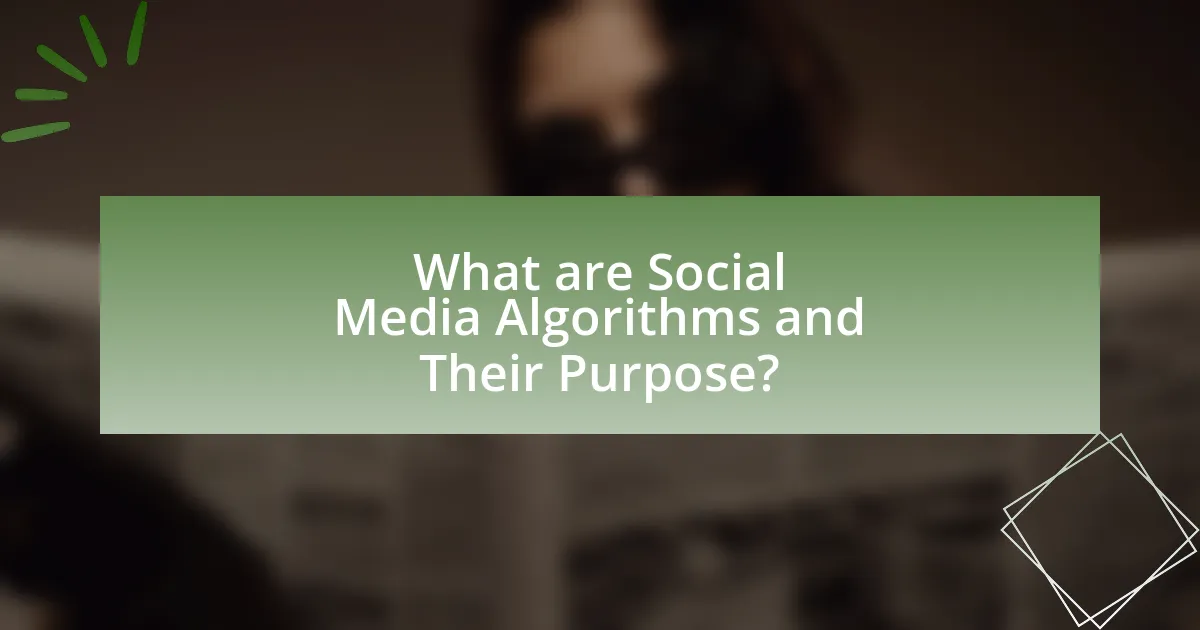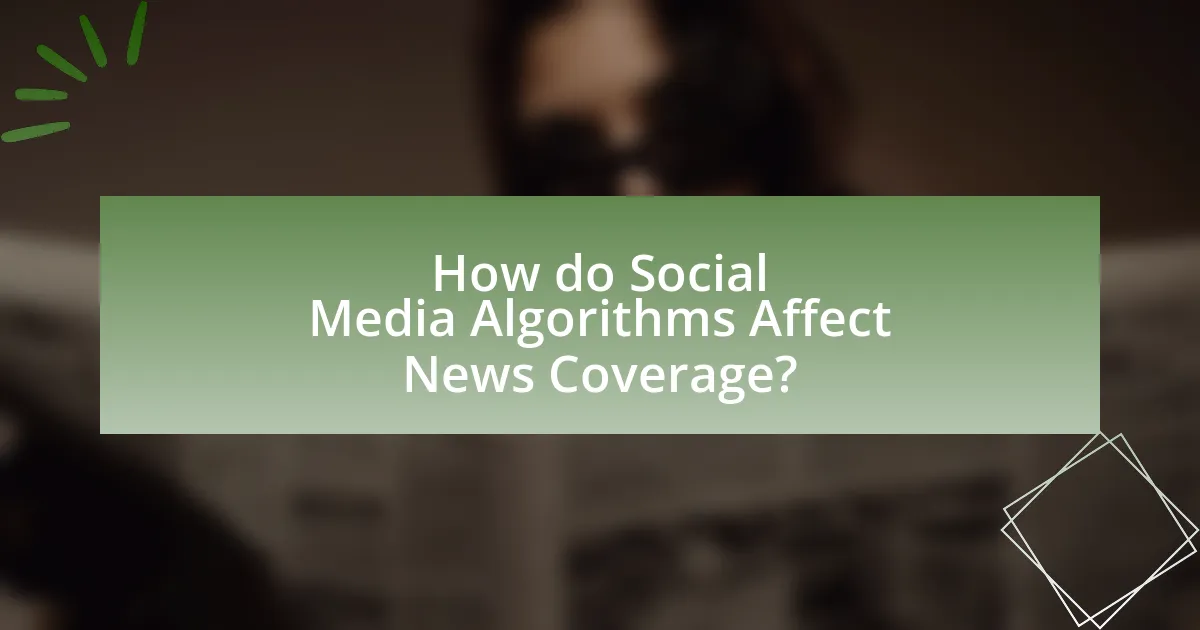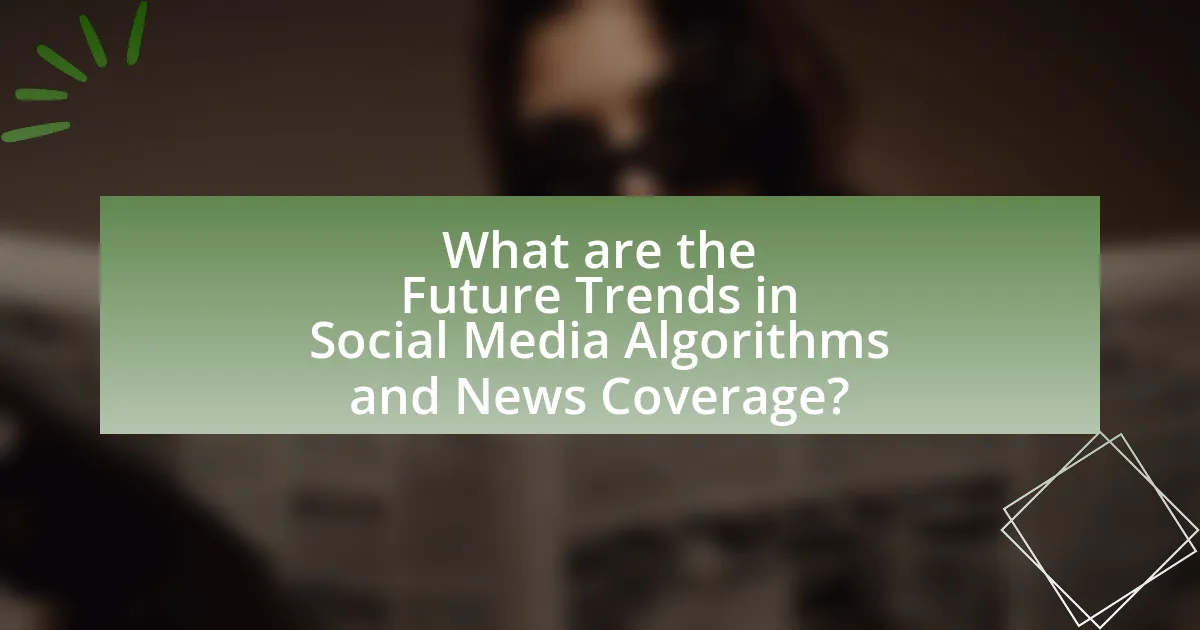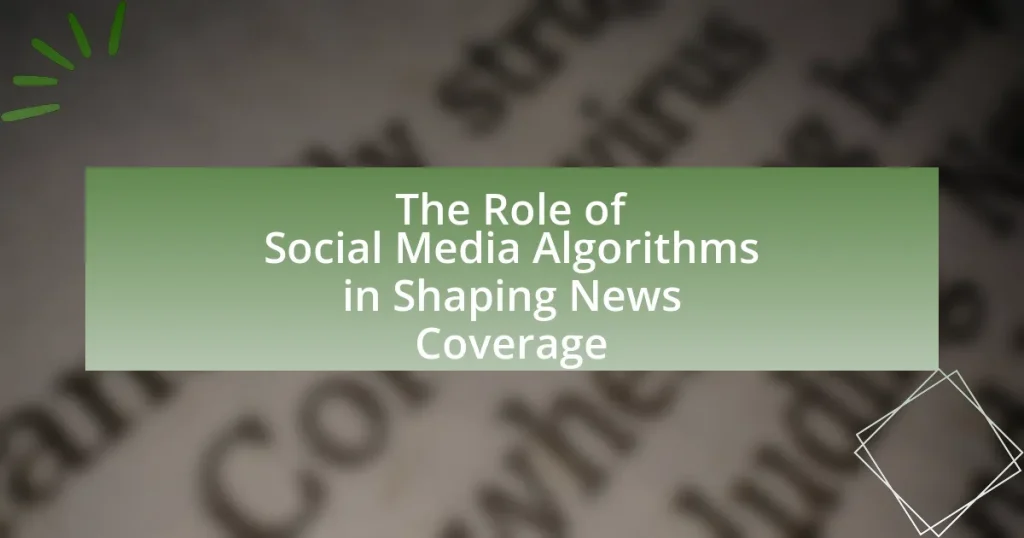Social media algorithms are mathematical formulas that determine the relevance and visibility of content on platforms like Facebook and Twitter, significantly influencing news dissemination and audience engagement. These algorithms analyze user interactions, such as likes and shares, to curate personalized news feeds, which can lead to echo chambers and shape public perception. The article explores how algorithms impact news coverage, the data they analyze, their role in audience engagement, and the potential negative consequences, including the spread of misinformation and bias. Additionally, it discusses future trends in algorithm development, the importance of transparency, and best practices for news organizations to ensure ethical use of algorithms in news reporting.

What are Social Media Algorithms and Their Purpose?
Social media algorithms are complex mathematical formulas used by platforms to determine the relevance and visibility of content to users. Their primary purpose is to enhance user engagement by personalizing the content feed based on individual preferences, behaviors, and interactions. For instance, Facebook’s algorithm prioritizes posts that generate more interactions, such as likes and comments, thereby influencing what news articles users see. This personalization can significantly shape public perception and information dissemination, as seen in studies showing that algorithm-driven feeds can lead to echo chambers, where users are exposed primarily to viewpoints that align with their own.
How do social media algorithms function in news dissemination?
Social media algorithms function in news dissemination by prioritizing content based on user engagement metrics, such as likes, shares, and comments. These algorithms analyze user behavior to curate a personalized news feed, promoting articles that are likely to generate interaction. For instance, Facebook’s algorithm uses a ranking system that considers factors like the recency of posts and the relationship between users and content creators, which influences what news appears prominently in users’ feeds. Research indicates that this approach can lead to echo chambers, where users are exposed primarily to viewpoints that align with their own, thus shaping public perception and discourse around news topics.
What data do social media algorithms analyze to shape news coverage?
Social media algorithms analyze user engagement data, including likes, shares, comments, and time spent on posts, to shape news coverage. This data helps algorithms determine which stories are trending and likely to resonate with users, thereby influencing the visibility of news articles. For instance, a study by the Pew Research Center found that 62% of adults get news from social media, highlighting the impact of engagement metrics on news dissemination. Additionally, algorithms consider demographic information and user behavior patterns to tailor news feeds, ensuring that content aligns with individual preferences and interests.
How do user interactions influence algorithmic decisions?
User interactions significantly influence algorithmic decisions by providing data that shapes content recommendations and visibility. Algorithms analyze user behaviors such as likes, shares, comments, and time spent on posts to determine what content is relevant and engaging. For instance, a study by Facebook revealed that posts receiving higher engagement are prioritized in users’ news feeds, thereby amplifying their reach. This feedback loop means that content creators often tailor their posts to elicit more interaction, further reinforcing the algorithm’s preferences.
Why are social media algorithms important for news organizations?
Social media algorithms are crucial for news organizations because they determine the visibility and reach of news content to audiences. These algorithms analyze user behavior and preferences, enabling news organizations to tailor their content for maximum engagement. For instance, a study by the Pew Research Center found that 62% of U.S. adults get news from social media, highlighting the importance of algorithms in directing traffic to news articles. By optimizing content based on algorithmic insights, news organizations can enhance their audience engagement and ensure that relevant news reaches the right users effectively.
How do algorithms impact the visibility of news articles?
Algorithms significantly impact the visibility of news articles by determining which content is prioritized in users’ feeds. These algorithms analyze user behavior, engagement metrics, and content relevance to curate a personalized news experience. For instance, Facebook’s algorithm favors articles that generate high engagement, such as likes and shares, which can lead to increased visibility for those articles while potentially suppressing less engaging content. Research by the Pew Research Center indicates that 62% of Americans get news from social media, highlighting the critical role algorithms play in shaping public access to information.
What role do algorithms play in audience engagement with news content?
Algorithms significantly influence audience engagement with news content by determining what information is prioritized and presented to users. These algorithms analyze user behavior, preferences, and interactions to curate personalized news feeds, which can enhance user engagement by delivering relevant content. For instance, a study by the Pew Research Center found that 62% of Americans get news on social media, where algorithms play a crucial role in shaping what stories are seen based on user engagement metrics such as likes, shares, and comments. This tailored approach can lead to increased time spent on platforms and higher interaction rates with news articles, ultimately affecting how news is consumed and understood by the audience.

How do Social Media Algorithms Affect News Coverage?
Social media algorithms significantly influence news coverage by prioritizing content that generates higher engagement, such as likes, shares, and comments. These algorithms analyze user behavior and preferences, leading to the amplification of sensational or emotionally charged news stories while potentially sidelining important but less engaging topics. For instance, a study by the Pew Research Center found that 62% of U.S. adults get news on social media, indicating that algorithms play a crucial role in determining which news reaches audiences. Consequently, this can create echo chambers, where users are exposed primarily to viewpoints that align with their own, thereby shaping public perception and discourse around news events.
What are the positive impacts of algorithms on news coverage?
Algorithms positively impact news coverage by enhancing personalization, improving content discovery, and increasing engagement. Personalization allows algorithms to tailor news feeds to individual preferences, ensuring users receive relevant information that aligns with their interests. For instance, platforms like Facebook and Twitter utilize algorithms to analyze user behavior, which results in a more customized news experience. Improved content discovery occurs as algorithms prioritize trending topics and breaking news, making it easier for users to access timely information. Research from the Pew Research Center indicates that 62% of Americans get news from social media, highlighting the role of algorithms in facilitating access to diverse news sources. Increased engagement is evident as algorithms promote interactive content, encouraging users to participate in discussions and share articles, thereby amplifying the reach of news stories.
How do algorithms enhance the personalization of news feeds?
Algorithms enhance the personalization of news feeds by analyzing user behavior, preferences, and interactions to curate content that aligns with individual interests. These algorithms utilize data such as past clicks, likes, shares, and time spent on articles to predict what users are likely to engage with next. For instance, Facebook’s algorithm prioritizes posts from friends and groups that users interact with most frequently, ensuring that the news feed reflects their social connections and interests. This targeted approach increases user engagement and satisfaction, as studies show that personalized content can lead to a 50% increase in user interaction rates.
What benefits do algorithms provide for news distribution efficiency?
Algorithms enhance news distribution efficiency by optimizing content delivery based on user preferences and engagement patterns. They analyze vast amounts of data to identify trending topics and tailor news feeds, ensuring that users receive relevant information quickly. For instance, Facebook’s algorithm prioritizes posts that generate high engagement, resulting in faster dissemination of popular news stories. This targeted approach not only increases user satisfaction but also boosts the visibility of important news, as evidenced by studies showing that algorithm-driven platforms can significantly increase the reach of breaking news compared to traditional methods.
What are the negative consequences of relying on algorithms for news coverage?
Relying on algorithms for news coverage can lead to significant negative consequences, including the amplification of misinformation and the creation of echo chambers. Algorithms prioritize content based on engagement metrics, often promoting sensational or misleading information that attracts clicks, which can distort public perception and understanding of important issues. A study by the MIT Media Lab found that false news stories spread six times faster than true stories on social media platforms, highlighting the detrimental impact of algorithm-driven news dissemination. Additionally, algorithms tend to reinforce existing biases by curating content that aligns with users’ preferences, limiting exposure to diverse viewpoints and fostering polarization within society. This reliance on algorithms ultimately undermines the quality of journalism and the informed public discourse necessary for a healthy democracy.
How can algorithms contribute to the spread of misinformation?
Algorithms can contribute to the spread of misinformation by prioritizing content that generates high engagement, often regardless of its accuracy. Social media platforms utilize algorithms that favor sensational or emotionally charged posts, which can lead to the amplification of false information. For instance, a study by Vosoughi, Roy, and Aral published in “Science” in 2018 found that false news stories spread more rapidly on Twitter than true stories, primarily due to algorithmic bias towards engaging content. This tendency for algorithms to promote misleading information over factual reporting creates an environment where misinformation can thrive and reach a wider audience.
What biases can emerge from algorithm-driven news selection?
Algorithm-driven news selection can lead to biases such as confirmation bias, filter bubbles, and sensationalism. Confirmation bias occurs when algorithms prioritize content that aligns with users’ existing beliefs, limiting exposure to diverse viewpoints. Filter bubbles arise when algorithms tailor news feeds based on user behavior, isolating individuals from differing perspectives and reinforcing their preconceptions. Sensationalism is often amplified as algorithms favor attention-grabbing headlines and emotionally charged content to maximize engagement, which can distort the representation of news events. Research by Pariser (2011) in “The Filter Bubble” highlights how personalized content can create a skewed perception of reality, demonstrating the significant impact of algorithmic selection on public discourse.

What are the Future Trends in Social Media Algorithms and News Coverage?
Future trends in social media algorithms and news coverage include increased personalization, enhanced use of artificial intelligence, and a focus on transparency. Social media platforms are likely to refine algorithms to deliver more tailored content based on user behavior and preferences, which can lead to echo chambers but also improved user engagement. The integration of advanced AI technologies will enable platforms to analyze vast amounts of data, optimizing content delivery and potentially identifying misinformation more effectively. Additionally, there is a growing demand for transparency in how algorithms operate, driven by public concern over bias and misinformation, prompting platforms to disclose more about their algorithmic processes. These trends are supported by studies indicating that personalized content can significantly increase user interaction rates, while transparency initiatives can enhance user trust in social media platforms.
How are algorithms evolving in response to user feedback?
Algorithms are evolving in response to user feedback by incorporating machine learning techniques that analyze user interactions to refine content delivery. Social media platforms, such as Facebook and Twitter, utilize user engagement metrics—like likes, shares, and comments—to adjust their algorithms, ensuring that content aligns more closely with user preferences. For instance, a study by the Pew Research Center found that 64% of users reported that social media algorithms significantly influence the news they see, prompting platforms to prioritize content that generates higher engagement. This iterative process allows algorithms to adapt in real-time, enhancing user satisfaction and retention by delivering more relevant news coverage.
What innovations are being introduced to improve algorithm transparency?
Innovations being introduced to improve algorithm transparency include the development of explainable AI (XAI) frameworks, which provide insights into how algorithms make decisions. These frameworks utilize techniques such as feature importance scores and decision trees to clarify the factors influencing algorithm outputs. For instance, companies like Google and Facebook are implementing model interpretability tools that allow users to understand the reasoning behind content recommendations. Research by Lipton (2016) highlights the importance of interpretability in machine learning, emphasizing that transparent algorithms can enhance user trust and accountability.
How might changes in regulations affect social media algorithms?
Changes in regulations can significantly alter social media algorithms by imposing new compliance requirements that dictate content moderation, data privacy, and transparency. For instance, the European Union’s General Data Protection Regulation (GDPR) has already influenced how platforms handle user data, leading to algorithm adjustments that prioritize user consent and data protection. Additionally, regulations aimed at combating misinformation may require algorithms to prioritize fact-checked content, thereby reshaping the types of news coverage that users encounter. These regulatory changes can lead to a more controlled and potentially less diverse information ecosystem, as platforms adapt their algorithms to meet legal standards and avoid penalties.
What best practices can news organizations adopt regarding algorithms?
News organizations can adopt best practices regarding algorithms by prioritizing transparency, accountability, and diversity in their algorithmic processes. Transparency involves clearly communicating how algorithms influence news distribution and content selection, which can help build trust with audiences. Accountability can be achieved by regularly auditing algorithms for bias and ensuring they align with journalistic standards, as evidenced by studies showing that biased algorithms can skew public perception. Additionally, incorporating diverse perspectives in algorithm design can mitigate echo chambers and enhance the representation of varied viewpoints, supported by research indicating that diverse teams produce more balanced outcomes.
How can news outlets ensure ethical use of algorithms in news coverage?
News outlets can ensure ethical use of algorithms in news coverage by implementing transparency, accountability, and diversity in their algorithmic processes. Transparency involves clearly communicating how algorithms influence news selection and presentation, allowing audiences to understand potential biases. Accountability can be established through regular audits and assessments of algorithmic performance, ensuring that they align with ethical standards and do not perpetuate misinformation or discrimination. Additionally, incorporating diverse perspectives in algorithm design can mitigate biases, as evidenced by research from the AI Now Institute, which highlights that diverse teams are more likely to identify and address ethical concerns in technology.
What strategies can be implemented to mitigate algorithmic bias?
To mitigate algorithmic bias, organizations can implement strategies such as diverse data sourcing, algorithmic auditing, and bias detection tools. Diverse data sourcing ensures that training datasets represent a wide range of demographics and perspectives, reducing the risk of skewed outcomes. Algorithmic auditing involves regularly reviewing algorithms for biased outcomes and making necessary adjustments, which has been shown to improve fairness in decision-making processes. Additionally, bias detection tools can identify and flag potential biases in algorithms before deployment, as evidenced by studies indicating that proactive bias detection can significantly enhance algorithmic fairness.




